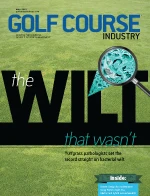 Pat Jones Pat Jones |
I started in this crazy business back in the Cenozoic Age as a cub reporter at GCSAA. I knew bupkis about turf, golf or – god forbid – the science that drives our industry. I was just a $16,000-a-year newbie in a cheap suit who was hired to edit press releases, write up little news items and maybe write a feature story or two. I was completely clueless. My first couple of days on the job were largely spent trying to figure out where the coffee maker was and how to use this amazing new technology called a “facsimile machine.” I was very proud of my Tandy 200 laptop with the tiny LCD screen and a fancy dial-up modem attachment that supposedly allowed you to transmit documents over the phone. I say “supposedly” because, as I recall, it never once worked properly. There’s a good reason the Tandy brand doesn’t exist anymore. Anyway, I was wet behind the ears and just getting started when my office phone rang. The gentleman on the other end of the line was Dr. Houston Couch, the legendary Virginia Tech plant pathologist. He warmly welcomed me to the business and offered to be a source for any story related to turf diseases. We talked casually for 20 minutes or so before I finally asked him if there was anything specific he wanted from me. His response – which I’ll never forget – was: “Yes… if you talk to a young whippersnapper named Joe Vargas, ignore everything he tells you.” That was my introduction to the always-interesting and entertaining world of academic disagreements. Though usually not as colorful as the great Couch vs. Vargas debate, disputes over disparate views of the finer points of turf science – particularly about the source and nature of disease pathogens – are common. They are like goose turds around ponds – unavoidable, stinky and usually invisible until you step on them. Well, we stepped into a steaming pile a few months ago with what we thought was a relatively straightforward piece about bacterial wilt. We knew that there’d been more than a little discussion and debate about the nature of the condition, what caused it and what to do about it, so we did a short item on the topic. A few days after publication, I was blithely scrolling through Facebook when I noticed that our newest columnist, Dr. John Kaminski, had posted something mentioning GCI. Oh goody, I thought, how nice that John is supporting us. Wrong. In fact, the good doctor was proclaiming how bad that bacterial wilt story was and publicly saying he was thinking of resigning. I got in touch with him right away and asked why he was throwing us under the bus. I learned that, a) there was nothing factually wrong with the story… he just disagreed with some of the other PhDs we quoted, and b) he had no intention of resigning… he just wanted to be provocative to get people talking about it. Oh…er…thanks? (Note: Although we sincerely congratulate John on earning his tenure at Penn State earlier this month, we do marvel a bit at what he’ll be like now that he is free to do and say whatever he wishes. Be afraid people, be very afraid.) So, once again, we find ourselves at ringside as academia’s best and brightest minds duke it out over whose theory is right. And, that’s fine because reasonable minds will differ and the debate will, we hope, eventually lead to consensus and a solution – which is all superintendents want in the first place. So, in that spirit, we asked our associate editor Kyle Brown to dig deeper into the differing views of bacterial wilt with an eye toward finding out if any consensus is developing. It turns out that reasonable minds are beginning to agree and things seem to be coalescing around work done by (surprise!) that whippersnapper Joe Vargas. I suspect that our deeper look at the issue will probably generate even more discussion by the “reasonable minds” of research as the apparently shallow one we did earlier. And you know what? That’s good by me because, ultimately, Dr. Kaminski was right: the more it’s talked about the sooner we’ll have real answers to the mystery condition known as bacterial wilt. |

Explore the May 2012 Issue
Check out more from this issue and find your next story to read.
Latest from Golf Course Industry
- ’Twas the Night Before Christmas (on turf)
- Twas the Night Before Christmas (the turf version audio)
- Advanced Turf Solutions and The Aquatrols Company release soil surfactant
- Heritage Golf Group acquires North Carolina courses
- Editor’s notebook: Green Start Academy 2024
- USGA focuses on inclusion, sustainability in 2024
- Greens with Envy 65: Carolina on our mind
- Five Iron Golf expands into Minnesota





